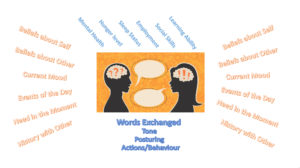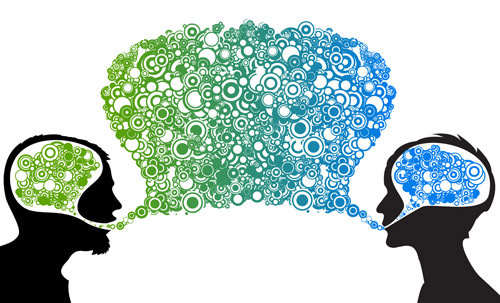Many issues between couples, parent-child relationships, friends, and colleagues, have to do with problematic patterns in communication and interactions. As humans, with human intentions and human needs, we enter most situations with some purpose. Occasionally, this purpose is known by one of the persons in the exchange; but very often a person enters into a conversation or situation without explicit insight into even their own true intentions and needs. Each exchange with another human carries with it numerous underlying factors. Not only are we dealing with the specific words being exchanged, but there are countless underlying beliefs, attitudes, impressions, and thoughts that contribute to each and every conversation, and these further include nonverbal interactions.
As you are probably well aware, attractiveness, warmth, friendliness, and intelligence are important in both first impressions and ongoing interactions (Myers, 2008). If you’ve thought about this in much depth, you may have considered the impact of ones tone, posture, or actions within a conversation – as these are extremely important to ongoing communications. It is through loud volume or high pitch that one can convey emergency, immediacy, fear, panic, anger, or excitement, regardless of the words being used. If you’ve ever heard a person exclaim: “eeeeeee!” while clapping or jumping, you will note that you must see their facial expression to know whether this is fear or excitement. In the same way, one single sentence or phrase can convey many meanings by changing the tone. Take this audio clip for example:
Give it a try. (It’s actually pretty fun!)
In addition to tone, it is through posture and behaviour (expressions, looks, and gestures), that we truly demonstrate the feelings we have, on purpose or not. Imagine someone telling you they love you – but they do it with a roll of the eyes and a quick look to the left. Not so good, is it? Consider telling someone about your day as they stare into their phone or keep closing their eyes for a period of time. Sure doesn’t encourage you to share, does it? This last point is more critical in recent years, and it’s my opinion that we should be careful to recognize our subtle behaviours regarding technology. Is it not slightly degrading that the person you are interacting with would prioritize an incoming text or phone call over you? I’m confident this is not a conscious decision by most, but in much the same way that little pestering actions gradually annoy a person over time, this too must have an impact on the connection between two people. But, I digress.
Below is a visual I put together to help make my point clear. Now that we’ve discussed the surface-level features of personal interactions, we can delve into the more often concealed features. Some of you may be aware of your own beliefs and values that are concealed within your interaction styles and inform your communication patterns with your spouse, child, or friend, but you may be unaware of the importance and role these beliefs play in your everyday dynamic. I don’t say this to discredit your awareness of yourself, but this level of insight takes a great deal of consideration, awareness, self-exploration, openness, and willingness to explore. In this blog post, I will simply explain the concepts, as each individual has their own biology and experiences that inform these features. It is for you to consider, as by simply considering these things, you may find yourself more able to change the problematic dynamics and patterns that exist in your own relationships. It is not to say that this will improve things, but sometimes a little consideration goes a long way. So, take a look at the visual I’ve provided:

As you can see from this image, we are bound to have different patterns with different people, depending on what they bring to the exchange. You may find that you cycle through familiar patterns with many people, or tend to relive the same pattern with one person in particular, no matter how hard you try to change it. Both these scenarios are likely because of unaddressed primary beliefs or values. Take for example, an adolescent child and her mother. This dynamic is already complex, no doubt, as the relationship is likely changing from one of parental control to a more hands off management model. Without considering each individual, there already exists a natural and common dynamic of the youth seeking greater independence and the parent learning how to enable this while remaining cautious and protective. (I have another post on this dynamic alone). But there exist so many other features to consider. As the above image demonstrates, not only might the exchange depend on the day each person had, the mood they are each in, and their needs in the moment, but it also depends on each personal fundamental beliefs about themselves (e.g., self-concept, abilities as a parent, capability as a person), beliefs about the other (e.g., how warm and caring, how open, how calm, ability to listen, mutual sense of respect), and the history that exists between the two (both reality and perception matter here). First consider the “need in the moment,” as this is frequently unspoken – for example, imagine the child asking for something they want, and the parent responds in whatever way they might, but perhaps parent or child really just needed some compassion and a hug for whatever reason. When relationships become strained, this strain and tension can often be seen in almost every exchange. Underlying each communication might be the risk of a past insult or past harm replaying itself. The more protective of the self a person becomes, the more entrenched the pattern becomes.
Finally, we must consider each individuals worldview. A worldview relates not only to self-perceptions but to perceptions of others. A worldview might mean to one person that all people are inherently good and trying to make their way through this life the best they can, while to another it might mean they must protect themselves and their heart at all costs because others cannot be trusted. Such world-views (and these are extreme examples) are developed through life experience and personality. I am not here to judge or demonstrate changing either; I am here to simply offer insight into the possibilities and reasons why two people might find themselves in a problematic pattern of interaction.
As you can see, changing patterns is not easy. Even once you reflect on your own beliefs and worldview, and especially once you reflect on the world view of the other in your interaction, change is not always readily accepted. Despite the challenges, humans cherish the familiar; we somehow find comfort in the pattern, even when the pattern is flawed. As such, if only one person in the exchange decides to change and that change is not communicated carefully and effectively, they can often experience resistance from the other. Imagine, if you are used to a certain response from your spouse when you come home from work, and one day this response changes somewhat drastically, you might wonder what has happened. You might question things about your relationship or about yourself. Your reaction and the others, depend on worldview and experiences. What if you or the other have had a previous experience in which a change in behaviour meant something bad was coming. By putting yourself in the other persons shoes, you might be able to see past the immediate exchange and understand where a certain tone, mood, or expression is coming from. Perhaps it has nothing to do with you.
Having said this, history matters, and therefore, so too does communication. By talking with the other person and relating to them, you can work together to develop new patterns. With children and youth, this also holds true and can often be overlooked. But it is through mutual respect, understanding, empathy, and communication, that we can teach our children how to navigate complex emotions, feelings, and experiences. By doing this, we also develop new dynamics and patterns. When you recognize a pattern, mention it. If the person is trustworthy and willing to explore this pattern with you, you will likely find that you can both improve the situation quite successfully. Communication, however, does not mean telling the person the problems you see. In this case (and most), it involves sharing what your needs are and why you might be interacting in the way you are. Through many discussions and respectful conversations about this, you can both learn about each other and find ways to navigate the challenges of your relationship.
The process is not without anxiety – this is stressful and difficult, and may require the support of a counsellor or psychologist to help mediate some of these exchanges in the early stages. But if you can express patience and can demonstrate a willingness to wait as you both work through various possible features underlying your communication and interactions, you are bound to have success.
As a final note, despite all the complexities of human interaction, a persons mental health, hunger levels, sleep status, employment issues, social skills, and learning profile, are also important to consider. Clearly, human interactions are not simple, are not surface or shallow, and rarely express only what can be seen at face-value. If you are considering the multitude of factors that play into your exchanges, you are already on the right track. Changing these patterns is possible, it just takes thought, work, and will.
References:
Myers, D. G. (2008). In pursuit of big ideas: Interview with David Myers, by J. Babutzke, R. Bannon, & K. Stephenson, Journal of Psychological Inquiry.

